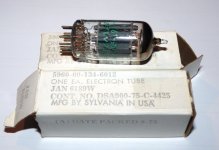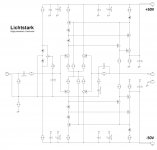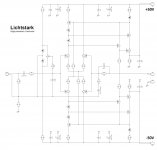Hello All,
Here is the full package, including both gerbers and pdf files for etching, as well as the hi-res schematic in pdf.
Right now it's set for +/-70V rails. For lower rails a few resistor values must be amended - let me know the desired voltage, I will come back to you with the values.
Have fun! Note - this is v1.0, so the need for some fine-tuning may arise before it becomes a mature "product". As soon as you build it - first test it standalone. Let me know is you will have questions.
Cheers,
Valery
I would like to know that is there anything in the Lichtstark to set the VAS to OPS stage current of 5.5ma? or is it fixed automatically? as I dont see any pot or variable value to set it.
I would like to know that is there anything in the Lichtstark to set the VAS to OPS stage current of 5.5ma? or is it fixed automatically? as I dont see any pot or variable value to set it.
Hi rhythmsandy,
Attached is the "as built" version of Lichtstark front-end.
VAS idle current is set by R12, R13. The values shown are valid for +/-50V rails, resulting in 5.5-5.7mA at VAS output.
It's never required to set the VAS idle current precisely, so most front-end designs don't have any trimmers for adjusting it. You set it during initial testing - that's it, then it will be roughly the same in all future builds.
Note - the right values depend on the rails voltage.
Cheers,
Valery
Attachments
Hi rhythmsandy,
Attached is the "as built" version of Lichtstark front-end.
VAS idle current is set by R12, R13. The values shown are valid for +/-50V rails, resulting in 5.5-5.7mA at VAS output.
It's never required to set the VAS idle current precisely, so most front-end designs don't have any trimmers for adjusting it. You set it during initial testing - that's it, then it will be roughly the same in all future builds.
Note - the right values depend on the rails voltage.
Cheers,
Valery
Thank you..
What is the advantage of Lichtstark over Bipsumo or Tubsumo or kypton?
Thank you..
What is the advantage of Lichtstark over Bipsumo or Tubsumo or kypton?
I found all the current drive inputs to be more immune to external noise. They are easier to install in a chassis and keep quiet. I haven't formally measured the Lichtstark yet but it's very similar to the VHex which does extremely well for it's simplicity.
Thank you..
What is the advantage of Lichtstark over Bipsumo or Tubsumo or kypton?
The other ones you've mentioned are very fine ones, however, even though they utilize some cool ideas, they represent a more "traditional" multi-stage voltage-driven amplification topologies.
As Jeff just mentioned, Lichtstark is based on a simple "current drive" principle. Basically, two stages - transconductance stage, converting the input voltage into current, and then immediately transimpedance stage (high-precision current mirror with gain), converting that current back to voltage with higher swing.
Key advantages of "current drive" based front-ends family (and Lichtstark in particular):
- High immunity to external noises, especially EMF-induced ones;
- Low distortion open-loop - i-to-v (transimpedance) stage is highly linear;
- Low phase shifts throughout the whole audio bandwidth, requiring very low compensation for demonstrating high stability margins and resulting in very good - accurate, natural - sound reproduction;
- High enough slew rate by design - "current drive" front-ends easily achieve 150-400V/uS, providing high dynamic characteristics;
- In overall, very short "signal path", low parasitic phase shifts and combination of high "speed" and high linearity nature of the circuit, provide high-precision operation, resulting in excellent sound, very low noise, and ease of use with virtually any OPS, maintaining high overall stability of the amplifier.
OK, this is a kind of "engineering stuff", key design characteristics.
Try it, listen to it 😉 Hear the difference 😎
A number of layouts are available, including my initial layout (bigger 100x100mm board) and the one, designed by idefixes (smaller 76x100mm board).
Cheers,
Valery
Hi rhythmsandy,
Attached is the "as built" version of Lichtstark front-end.
VAS idle current is set by R12, R13. The values shown are valid for +/-50V rails, resulting in 5.5-5.7mA at VAS output.
It's never required to set the VAS idle current precisely, so most front-end designs don't have any trimmers for adjusting it. You set it during initial testing - that's it, then it will be roughly the same in all future builds.
Note - the right values depend on the rails voltage.
How do you take care of taming DC offset? DC Servo?
How do you take care of taming DC offset? DC Servo?
Servo is an option, however symmetric topology is rather thermally stable, so a simple trimmer (R6) is enough for zeroing-out the offset.
My VHex prototype uses a trim pot for DC offset and after the initial burn in is very stable. Power up is ~3mV offset decreasing to 0 after about a minute.
I do not mean zeroing DC offset, which is easy to do, but keeping it within a few millivolts.
If you say otherwise you would be misguiding many people here in the forum who have little or no experience with amplifiers.
Keeping an amp close to zero DC is very difficult, and thermal runaway is very difficult to control.
Either you need a NFB capacitor or DC servo. Or you will need a protection circuit to watch for DC and control the output with a relay.
If you say otherwise you would be misguiding many people here in the forum who have little or no experience with amplifiers.
Keeping an amp close to zero DC is very difficult, and thermal runaway is very difficult to control.
Either you need a NFB capacitor or DC servo. Or you will need a protection circuit to watch for DC and control the output with a relay.
On my prototype board I did an initial burn in heat cycle of a couple hours, then readjusted DC offset. I let it cool overnight and powered it up again. On power up offset was -3mV. After a couple minutes to warm up it settled to ~300uV and stayed there all day. It's steadier than most servoed amplifiers I've played with so far. Valery's current drive designs are different that the million Blameless designs out there. They are very stable.
Common sense should say always use DC offset protection for your speakers. We put a lot of time and effort into designing a great protection system to go with all these amps. http://www.diyaudio.com/forums/solid-state/264313-how-build-21st-century-protection-board.html
Common sense should say always use DC offset protection for your speakers. We put a lot of time and effort into designing a great protection system to go with all these amps. http://www.diyaudio.com/forums/solid-state/264313-how-build-21st-century-protection-board.html
I do not mean zeroing DC offset, which is easy to do, but keeping it within a few millivolts.
If you say otherwise you would be misguiding many people here in the forum who have little or no experience with amplifiers.
Keeping an amp close to zero DC is very difficult, and thermal runaway is very difficult to control.
Either you need a NFB capacitor or DC servo. Or you will need a protection circuit to watch for DC and control the output with a relay.
I'm sort of confused now - are we discussing particular circuit or possible approaches in general?
There is a number of ways to keep the offset within a few millivolts - depends on overall topology, input stage devices, feedback network arrangement, layout features (like input pair and possibly other pairs thermal coupling).
For some topologies servo is a must, some others are thermally stable by design (so, manual trimmer, or even no trimmer is enough).
Zero DC and thermal runaway are different things, so different control loops are used for dealing with them.
Soft-start / protection board is a must for any DC-coupled amplifier - we use comprehensive MCU-based control boards, providing all required functionality.
See the link in my signature for more details (21-st century control boards).
Cheers,
Valery
I'm not talking about DIY designs not to be DC stable, and by stable I mean say +/-10mV DC.
Look at most commercial amplifiers around, commercial products, that can afford dual transistors, thermal pairing active parts, etc, and practically all, except the most expensive ones, will have a capacitor on the NFB or a DC servo.
I have seen just the last schematics, and I don't remember the other ones here over having cap or DC servo.
Of course you can use none of that, and trust your amp will be stable. But then a protection system should be part of the project.
Look at most commercial amplifiers around, commercial products, that can afford dual transistors, thermal pairing active parts, etc, and practically all, except the most expensive ones, will have a capacitor on the NFB or a DC servo.
I have seen just the last schematics, and I don't remember the other ones here over having cap or DC servo.
Of course you can use none of that, and trust your amp will be stable. But then a protection system should be part of the project.
I designed two choices of protection systems specifically for the VHex series of amplifiers. The NS series amplifier boards have the DC detection, temperature sensor and solid state output relays built into the output board. Protection is part of all of our projects. We also have these same protection systems available to add onto any other amplifier. They've been very popular with the Honeybadger and Slewmaster amps.
Almost all of the NS series input designs use a DC servo. The Lichtstark version will also have a servo when Valery or I get some time to do a layout for it.
Almost all of the NS series input designs use a DC servo. The Lichtstark version will also have a servo when Valery or I get some time to do a layout for it.
I'm not talking about DIY designs not to be DC stable, and by stable I mean say +/-10mV DC.
Look at most commercial amplifiers around, commercial products, that can afford dual transistors, thermal pairing active parts, etc, and practically all, except the most expensive ones, will have a capacitor on the NFB or a DC servo.
I have seen just the last schematics, and I don't remember the other ones here over having cap or DC servo.
Of course you can use none of that, and trust your amp will be stable. But then a protection system should be part of the project.
What schematic are you talking about? I'm lost completely.
All my amplifiers keep the offset within +/-2-3mV, some of them keep it within +/-1mV. Built and tested.
Yes, sometimes it's servo, sometimes it's capacitor.
Where do you see the problem?
Protection is a separate story. It's involved only if something goes wrong. In normal operation - offset is within a few mV - it's not involved, although it's always there.
To start with, there is no problem that I am pointing at. Let's be clear of that.
I asked how the speakers were being protected from DC with the Lichtstark, that did not show any DC servo or cap.
The answer I got seemed to imply that none of them were being used, because the amp was stable. So I said you could that if you had a reliable DC protection at the output.
If the amp is really stable you won't have any interruptions, and time would say if the amp is DC stable in the long run.
That is all.
I asked how the speakers were being protected from DC with the Lichtstark, that did not show any DC servo or cap.
The answer I got seemed to imply that none of them were being used, because the amp was stable. So I said you could that if you had a reliable DC protection at the output.
If the amp is really stable you won't have any interruptions, and time would say if the amp is DC stable in the long run.
That is all.
To start with, there is no problem that I am pointing at. Let's be clear of that.
I asked how the speakers were being protected from DC with the Lichtstark, that did not show any DC servo or cap.
The answer I got seemed to imply that none of them were being used, because the amp was stable. So I said you could that if you had a reliable DC protection at the output.
If the amp is really stable you won't have any interruptions, and time would say if the amp is DC stable in the long run.
That is all.
If you refer to schematic from the post #2124 - I have attached it here again - isn't C8 a cap you're looking for? 😉
Attachments
😱
Of course it is! Just didn't see it!
😀
Ah, ok 🙂 That's what I thought at some point 😛
- Home
- Amplifiers
- Solid State
- Revisiting some "old" ideas from 1970's - IPS, OPS


